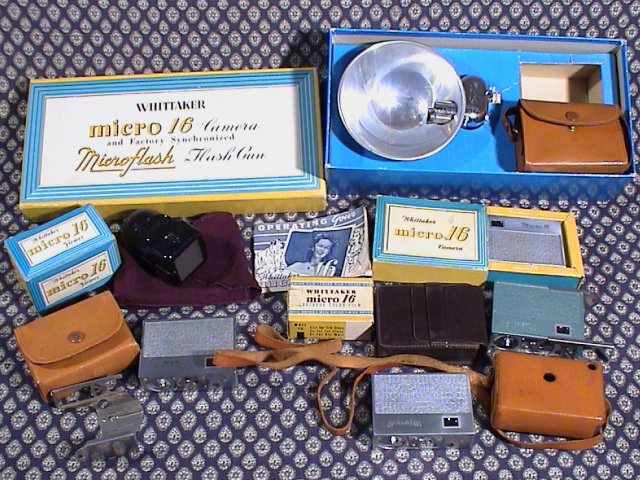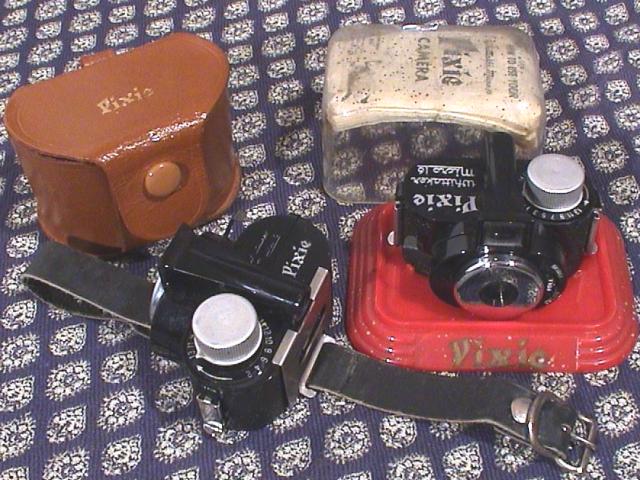Micro 16
The Whittaker Micro 16 is smaller than a pack of cigarettes at 71 x 51 x 23.5 mm (2 ¾" x 1" x 2") yet this all metal subminiature is heavy at 238g (8 3/8oz). Made in Hollywood, Los Angeles, California by the Wm. R. Whittaker Co. Ltd from 1947 into the '50's. The firm was owned by William and Robert Whittaker and had been a maker of aircraft parts. The camera was designed to fit into a cigarette wrapper and profit from the mystique of the Kodak-X matchbox camera. Hundreds where sold it police departments and detective bureaus throughout the United States.
The Micro 16 had a single speed shutter with a mediocre Achromatic doublet f6.3 lens. The camera has a waist-level viewfinder and an optional frame that clips on for direct line of site viewing, similar to the Mamiya 16.
Available in chrome (polished aluminium), black, blue, green and grey. The green is seen in an anodised matt finish, a rough look enamel and a lacquer finish. There are also variations in having the pebble dash top and bottom being in black, green or grey with the rest of the camera as polished aluminium.
The film advance teeth are set up for double perforated film operated by the bar at the side of the camera. Push in the end flush with the side, the bar pops out. Turn the camera upside down and push in the bar and the counter and the frame has moved on and allows a little gravity assisted latch to lock the plunger closed. The counter wheel is marked for 24 exposures. The feed and take up cassettes are identical and the mechanism pushes the film into the take up cassette. The cassette is similar and functional replacement for one of the variations in Mec 16 cassettes (made of tin plate). If the film is wound completely in then getting the tail end out again is difficult and the cassette is unlikely to be the same again.

The body is well made but the lens mediocre and the film advance mechanism often failed. Repairs are possible in an evening, but too late for the film in use. The reflex mirror is often loose and the silver backing lifting off.
Early: (late 1946 to mid 1947) Aperture selector lever, on the front of the camera, is a raised arrow with checked background and three Waterhouse1 stops marked "BRIGHT", "DULL", and "COLOR" (f11, f8, f6.3). Serial numbers engraved, showing tooth marks of rotary engraver.
Mid: Serial numbers lightly scratched by hand. "BRIGHT", "DULL", and "COLOR" filled with red enamel.
Later: Aperture selector lever has depressed arrow filled with red enamel on plain background.
Better results from the Micro 16 can be obtained by exposing the film 20% longer than with other 16mm cameras; which improves sharpness and effectively raises the working exposure index.
The flash attachment clips onto the side of the camera and covers the shutter release. The new release mechanism fires the flash and moves the camera's shutter release in one action.
Pixie
Whittaker Pixie was sold in 1950. It has a f6.3 lesn, a single speed shutter slightly larger than the HIT cameras with a plastic box and chrome plated lens surround. The f-stop had three settings, "BRIGHT", "DULL", and "COLOR" which were changed by a slider on the side of the camera. A version of the camera allowed for a huge flash unit to be attached. There is a wrist strap for the camera but this is a vulnerable location to carry a weak plastic camera.
